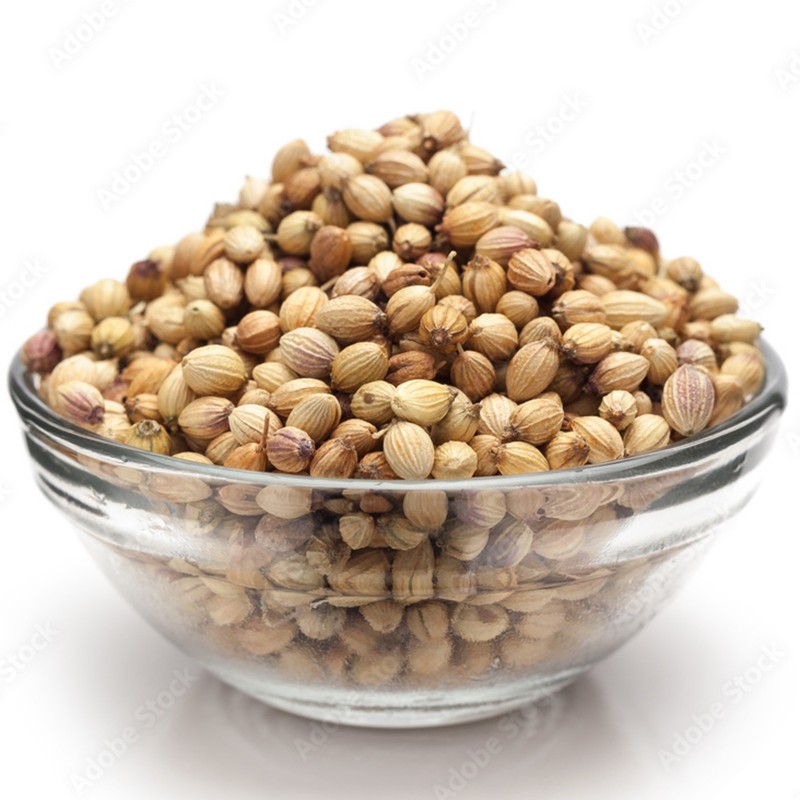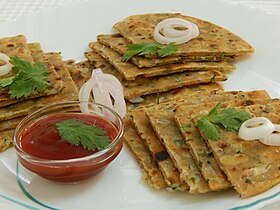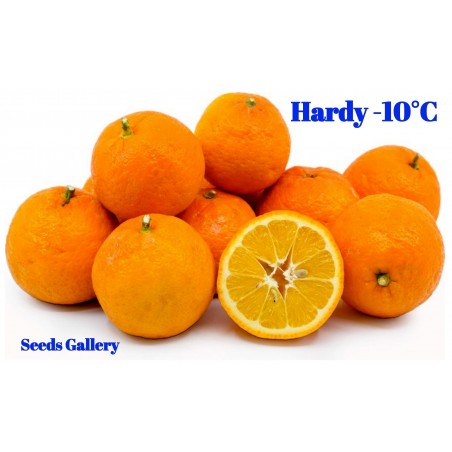
Coriander Seeds (Coriandrum Sativum)
Coriander Seeds Herb (Coriandrum Sativum)
Price for Package of 200 seeds (2g).
Coriander (/ˌkɒriˈændər, ˈkɒriændər/; Coriandrum sativum) is an annual herb in the family Apiaceae. It is also known as Chinese parsley, and in North America, the stems and leaves are usually called cilantro (/sɪˈlæntroʊ, -ˈlɑːn-/). All parts of the plant are edible, but the fresh leaves and the dried seeds (as a spice) are the parts most traditionally used in cooking.
Most people perceive the taste of coriander leaves as a tart, lemon/lime taste, but a smaller group of about 3–21% of people tested (depending on ethnicity) think the leaves taste like dish soap, linked to a gene which detects some specific aldehydes that are also used as odorant substances in many soaps and detergents
Botanical description

Coriander is native to regions spanning from Southern Europe and Northern Africa to Southwestern Asia. It is a soft plant growing to 50 cm (20 in) tall. The leaves are variable in shape, broadly lobed at the base of the plant, and slender and feathery higher on the flowering stems. The flowers are borne in small umbels, white or very pale pink, asymmetrical, with the petals pointing away from the center of the umbel longer (5–6 mm or 0.20–0.24 in) than those pointing toward it (only 1–3 mm or 0.039–0.118 in long). The fruit is a globular, dry schizocarp 3–5 mm (0.12–0.20 in) in diameter. Pollen size is approximately 33 microns.
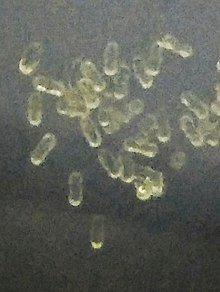
Etymology
First attested in English in the late 14th century, the word "coriander" derives from the Old French: coriandre, which comes from Latin: coriandrum,[4] in turn from Ancient Greek: κορίαννον, koriannon,[5][6] derived from Ancient Greek: κόρις, kóris (a bed bug), and was given on account of its foetid, bed bug-like smell.[7] The earliest attested form of the word is the Mycenaean Greek ko-ri-ja-da-na[8] written in Linear B syllabic script (reconstructed as koriadnon, similar to the name of Minos's daughter Ariadne) which later evolved to koriannon or koriandron,[9] and koriander (German).[10]
Cilantro is the Spanish word for coriander, also deriving from coriandrum. It is the common term in North American English for coriander leaves, due to their extensive use in Mexican cuisine.[10]
Origin
Although native to Iran,[11] coriander grows wild over a wide area of Western Asia and Southern Europe, prompting the comment: "It is hard to define exactly where this plant is wild and where it only recently established itself."[12] Fifteen desiccated mericarps were found in the Pre-Pottery Neolithic B level of the Nahal Hemar Cave in Israel, which may be the oldest archaeological find of coriander. About half a litre of coriander mericarps was recovered from the tomb of Tutankhamen, and because this plant does not grow wild in Egypt, Zohary and Hopf interpret this find as proof that coriander was cultivated by the ancient Egyptians.[12]
Coriander seems to have been cultivated in Greece since at least the second millennium BC. One of the Linear B tablets recovered from Pylos refers to the species as being cultivated for the manufacture of perfumes; it apparently was used in two forms: as a spice for its seeds and as a herb for the flavour of its leaves.[9] This appears to be confirmed by archaeological evidence from the same period; the large quantities of the species retrieved from an Early Bronze Age layer at Sitagroi in Macedonia could point to cultivation of the species at that time.[13]
Uses
All parts of the plant are edible, but the fresh leaves and the dried seeds are the parts most traditionally used in cooking, Coriander is used in cuisines throughout the world.[14]
-
-

Coriander leaves in coconut chutney
-
-
-

Minty pani puri
-
-
Onion coriander paratha
Leaves

The leaves are variously referred to as coriander leaves, fresh coriander, dhania, Chinese parsley, or (in the US and commercially in Canada) cilantro.
Coriander potentially may be confused with culantro (Eryngium foetidum L.), an Apiaceae like coriander (Coriandrum sativum L.), but from a different genus. Culantro has a distinctly different spiny appearance, a more potent volatile leaf oil[15] and a stronger aroma.
The leaves have a different taste from the seeds, with citrus overtones.[16]
The fresh leaves are an ingredient in many South Asian foods (such as chutneys and salads); in Chinese, Thai, and Burmese dishes; in Mexican cooking, particularly in salsa and guacamole and as a garnish; and in salads in Russia and other CIS countries. In Portugal, chopped coriander is used in the bread soup Açorda, and in India, chopped coriander is a garnish on Indian dishes such as dal.[17] As heat diminishes their flavour, coriander leaves are often used raw or added to the dish immediately before serving. In Indian and Central Asian recipes, coriander leaves are used in large amounts and cooked until the flavour diminishes.[10] The leaves spoil quickly when removed from the plant, and lose their aroma when dried or frozen.
Seeds
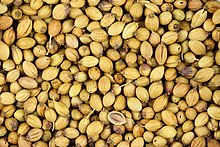
The dry fruits are known as coriander seeds. The word "coriander" in food preparation may refer solely to these seeds (as a spice), rather than to the plant. The seeds have a lemony citrus flavour when crushed, due to terpenes linalool and pinene. It is described as warm, nutty, spicy, and orange-flavoured.
The variety C. s. vulgare has a fruit diameter of 3–5 mm (0.12–0.20 in), while var. C. s. microcarpum fruits have a diameter of 1.5–3 mm (0.06–0.12 in). Large-fruited types are grown mainly by tropical and subtropical countries, e.g. Morocco, India, and Australia, and contain a low volatile oil content (0.1-0.4%). They are used extensively for grinding and blending purposes in the spice trade. Types with smaller fruit are produced in temperate regions and usually have a volatile oil content around 0.4-1.8%, so are highly valued as a raw material for the preparation of essential oil.[18]
Coriander is commonly found both as whole dried seeds and in ground form. Roasting or heating the seeds in a dry pan heightens the flavour, aroma, and pungency. Ground coriander seed loses flavour quickly in storage and is best ground fresh. Coriander seed is a spice in garam masala and Indian curries which often employ the ground fruits in generous amounts together with cumin, acting as a thickener in a mixture called dhana jeera.[19] Roasted coriander seeds, called dhana dal, are eaten as a snack. They are the main ingredient of the two south Indian dishes sambhar and rasam.
Outside of Asia, coriander seed is used widely in the process for pickling vegetables. In Germany and South Africa (see boerewors), the seeds are used while making sausages. In Russia and Central Europe, coriander seed is an occasional ingredient in rye bread (e.g. Borodinsky bread), as an alternative to caraway. The Zuni people of North America have adapted it into their cuisine, mixing the powdered seeds ground with chili and using it as a condiment with meat, and eating leaves as a salad.[20]
Coriander seeds are used in brewing certain styles of beer, particularly some Belgian wheat beers. The coriander seeds are used with orange peel to add a citrus character. Coriander seed is one of the main traditional ingredients in the South African Boerewors, a spiced mixed-meat sausage.
One preliminary study showed coriander essential oil to inhibit Gram-positive and Gram-negative bacteria, including Staphylococcus aureus, Enterococcus faecalis, Pseudomonas aeruginosa, and Escherichia coli.[21]
Coriander is listed as one of the original ingredients in the secret formula for Coca-Cola.[22]
Roots

Coriander roots have a deeper, more intense flavor than the leaves, and are used in a variety of Asian cuisines, especially in Thai dishes such as soups or curry pastes.
Nutrition
| Nutritional value per 100 g (3.5 oz) | |
|---|---|
| Energy | 95 kJ (23 kcal) |
|
Carbohydrates
|
3.67 g
|
| Sugars | 0.87 |
| Dietary fiber | 2.8 g |
|
Fat
|
0.52 g
|
|
Protein
|
2.13 g
|
| Vitamins | Quantity%DV† |
| Vitamin A equiv.
beta-Carotene
lutein zeaxanthin
|
42%
337 μg
36%
3930 μg865 μg
|
| Thiamine (B1) |
6%
0.067 mg |
| Riboflavin (B2) |
14%
0.162 mg |
| Niacin (B3) |
7%
1.114 mg |
| Pantothenic acid (B5) |
11%
0.57 mg |
| Vitamin B6 |
11%
0.149 mg |
| Folate (B9) |
16%
62 μg |
| Vitamin C |
33%
27 mg |
| Vitamin E |
17%
2.5 mg |
| Vitamin K |
295%
310 μg |
| Minerals | Quantity%DV† |
| Calcium |
7%
67 mg |
| Iron |
14%
1.77 mg |
| Magnesium |
7%
26 mg |
| Manganese |
20%
0.426 mg |
| Phosphorus |
7%
48 mg |
| Potassium |
11%
521 mg |
| Sodium |
3%
46 mg |
| Zinc |
5%
0.5 mg |
| Other constituents | Quantity |
| Water | 92.21 g |
Link to USDA Database entry
|
|
|
|
| †Percentages are roughly approximated using US recommendations for adults. Source: USDA Nutrient Database |
|
Raw coriander leaves are 92% water, 4% carbohydrates, 2% protein, and less than 1% fat (table). The nutritional profile of coriander seeds is different from the fresh stems or leaves. In a 100 gram reference amount, leaves are particularly rich in vitamin A, vitamin Cand vitamin K, with moderate content of dietary minerals (table). Although seeds generally have lower content of vitamins, they do provide significant amounts of dietary fiber, calcium, selenium, iron, magnesium and manganese.[23]
Taste and smell
The essential oil from coriander leaves and seeds contains mixed polyphenols and terpenes, including linalool as the major constituent accounting for the aroma and flavor of coriander.[24]
Different people may perceive the taste of coriander leaves differently. Those who enjoy it say it has a refreshing, lemony or lime-like flavor, while those who dislike it have a strong aversion to its taste and smell, characterizing it as soapy or rotten.[16][25] Studies also show variations in preference among different ethnic groups: 21% of East Asians, 17% of Caucasians, and 14% of people of African descent expressed a dislike for coriander, but among the groups where coriander is popular in their cuisine, only 7% of South Asians, 4% of Hispanics, and 3% of Middle Eastern subjects expressed a dislike.[26]
Studies have shown that 80% of identical twins shared the same preference for the herb, but fraternal twins agreed only about half the time, strongly suggesting a genetic component to the preference. In a genetic survey of nearly 30,000 people, two genetic variants linked to the perception of coriander have been found, the most common of which is a gene involved in sensing smells.[27] The gene, OR6A2, lies within a cluster of olfactory-receptor genes and encodes a receptor that is highly sensitive to aldehydechemicals. Flavor chemists have found that the coriander aroma is created by a half-dozen or so substances, and most of these are aldehydes. Those who dislike the taste are sensitive to the offending unsaturated aldehydes and at the same time may be unable to detect the aromatic chemicals that others find pleasant.[28] Association between its taste and several other genes, including a bitter-taste receptor, have also been found.
Allergy
Some people are allergic to coriander leaves or seeds, having symptoms similar to those of other food allergies.[30] In one study, 32% of pin-prick tests in children and 23% in adults were positive for coriander and other members of the family Apiaceae, including caraway, fennel, and celery.[30] The allergic symptoms may be minor or life-threatening.
| Organic Seeds ? | Organic Seeds |
|---|---|
| Organic/natural ? | Organic/Natural: Yes |
| Edible ? | Edible |
| Sowing depth ? | Sowing depth 5 mm |
| Semințe culese manual? | Semințe culese manual |
| Suitable for growing in flower pot ? | Suitable for pot: Yes |
| Medicinal Plant ? | Medicinal Plant: Yes |


Aprecierea ta pentru recenzie nu a putut fi trimisa
Reclama un comentariu
Raport trimis
Reclamatia tau nu a putut fi trimisa
Scrie-ti recenzia
Recenzia a fost trimisa
Recenzia ta nu a putut fi trimisa
🌍 Livrare Globală din UE
Expediem comenzi la nivel mondial din Uniunea Europeană prin poștă înregistrată cu confirmare de primire.
📦 Urmărirea coletului
Pentru a urmări coletul, autentifică-te în contul tău și accesează secțiunea Istoricul comenzilor > Detalii. Acolo vei găsi numărul de urmărire.
Urmărire internațională: 17Track
Pentru numere de tip RGxxxxxxHR: Posta.hr Tracking
🕒 Notă: Informațiile de urmărire devin disponibile după cel puțin 24 de ore de la expediere.
⚠️ Informații importante
Plata ramburs nu este disponibilă.
Verifică dosarul SPAM / Junk al e-mailului pentru a nu rata notificările.
Contactează-ne doar prin formularul de contact de pe site.
E-mailurile directe nu vor fi procesate.
📱 Număr de telefon obligatoriu
La plasarea comenzii, te rugăm să introduci numărul tău de telefon mobil cu prefixul internațional al țării.
Exemplu: +40 712 345 678
🚚 Condiții de livrare
Pentru coletele înregistrate, este necesară semnătura destinatarului.
Nu comanda dacă:
dorești ca pachetul să fie livrat într-o cutie poștală
nu vei fi acasă pentru a-l prelua
dorești ca pachetul să fie lăsat la un vecin (❌ acest lucru nu este posibil)
📬 Dacă oferi o adresă de tip cutie poștală și coletul se pierde, nu ai dreptul la ramburs.
↩️ Returnarea coletului și reexpediere
Dacă, din orice motiv, coletul este returnat către noi:
Vei fi responsabil pentru costul de retur de 2 €
Și pentru costul reexpedierii
⏱ Întârzieri și urmărire
Dacă urmărirea indică „la expeditor”, înseamnă că este în tranzit.
Contactează oficiul poștal local cu numărul de urmărire pentru informații actualizate.
Nu suntem serviciu poștal – nu putem urmări coletul în numele tău.
Nu ne asumăm responsabilitatea pentru timpii de livrare.
🔍 Putem începe o investigație doar după 30 de zile de la data expedierii.
✈️ Opțiuni de livrare
| Tip livrare | Timp procesare | Asigurare | Posibile întârzieri | Detalii |
|---|---|---|---|---|
| Standard | 7–10 zile lucrătoare | ❌ | 7–14 zile | Cea mai ieftină opțiune |
| Prioritară | 1–7 zile lucrătoare | ❌ | 3–10 zile | Comanda procesată prioritar, dar nu livrată mai rapid |
| Asigurată | 1–7 zile lucrătoare | ✅ | 3–10 zile | Rambursare garantată dacă coletul se pierde (până la 150 €) |
🕒 Timp estimativ de livrare:
În UE: 3–20 zile lucrătoare
Internațional: 5–30 zile lucrătoare
Exemple livrări SUA: 27, 22, 19, 17, 13 zile
💳 Metode de plată
💶 Transfer bancar (SEPA / IBAN / SWIFT-BIC)
În descrierea plății trebuie să menționezi codul comenzii (ex. SGS-19811702).
Dacă nu apare codul, comanda poate întârzia sau fi anulată.
Dacă plata nu este recepționată în 7 zile, comanda va fi anulată automat.
🅿️ PayPal
Acceptăm plăți doar în euro.
Te rugăm să selectezi euro în timpul procesului de plată.
💳 Card bancar
Plata se face pe site-ul nostru: Exotic Seeds Store
Acceptăm: Visa, MasterCard, American Express, Diners Club, Discover, JCB, UnionPay etc.
💡 Clientul suportă toate taxele de tranzacție.
Pentru procesare rapidă, trimite dovada plății.
📅 Observații suplimentare
Nu procesăm comenzi și nu expediem sâmbăta sau duminica.
Verifică întotdeauna anunțurile importante de pe site-ul nostru înainte de a plasa o comandă (ex. sărbători sau condiții speciale).
📫 Important:
Nu trimite mesaje pe adresa noastră de e-mail. Folosește exclusiv formularul de contact disponibil pe site-ul nostru.
Related Products

